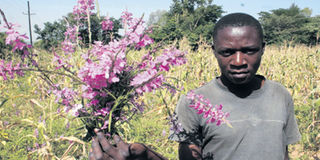How I stopped striga from ravaging my field of maize

A farmer, Eric Omondi, in a maize field infested with striga weed in Kombewa, Kisumu. FILE PHOTO | NATION MEDIA GROUP
What you need to know:
- Striga, also known as ‘‘witch weed’’, is a nightmare to farmers mainly in western Kenya. It affects maize, millet, sorghum, rice, napier grass and sugarcane.
- Joseph Muthamia, an agronomist with IPNI, says there is need for proper usage of NPK fertiliser when planting, particularly cereals, to contain striga.
- Besides good farming practices, he says farmers must follow the 4R (right) principles of nutrient management. These are right seeds, right planting season (early planting), right spacing and right plant population.
Athanasio Nyaoro walks in his maize farm as he randomly checks the crops to find out how they are doing.
He stops at a spot, opens up one of the maize cobs that had caught his interest before plucking it from the stem.
“They are almost ready for harvest,” says the farmer who is based in Mathai village, Siaya County.
It is the second season in many years that the farmer, who has grappled with striga weed for long, is going to have a bumper harvest.
The weed infested his two-acre farm in 2009 causing him losses.
“The maximum bags of maize I would harvest from my farm were four. In 2010, I remember I planted 5kg of maize seeds and I was expecting a minimum of 30 bags but I only got one.”
The farmer sought assistance from agricultural extension officers who visited his farm and identified striga weed as the cause of the poor harvest.
The officers advised Nyaoro to practise crop rotation to contain the beautiful purple-flowered weed. The advice, however, did not yield positive results.
NIGHTMARE TO FARMERS
Striga, also known as ‘‘witch weed’’, is a nightmare to farmers mainly in western Kenya. It affects maize, millet, sorghum, rice, napier grass and sugarcane.
The weed, according to crop experts, is parasitic and it poisons both the crop and the soil leading to poor harvest. The loss is projected at 80 per cent.
A desperate Nyaoro later sought the help of officers from International Plant Nutrition Institute (IPNI), an institution that deals with plant nutrition.
“They took soil samples from my farm and neighbouring ones for laboratory analysis. The results indicated that the soil was acidic and had low nitrogen, phosphorus and potassium,” says Nyaoro, who was later trained on good agricultural practices that helped him contain striga.
The farmer now uses two 50kg bags of NPK fertiliser per acre when planting maize, and he later top dresses with urea fertiliser.
However, Nyaoro no longer uses fertiliser haphazardly. When planting, he puts in each hole a teaspoon of the mineral.
He further ensures he plants certified hybrid seeds. “I am also keen on the planting season. I plant as soon as it starts raining.”
According to the farmer, waiting to plant when it has rained for weeks increases chances of striga infestation.
When it comes to spacing, he maintains 75cm from one row to another and 25 cm from one crop to the next.
PROPER WEEDING
“I normally plant two or three seeds in each hole and later uproot one after they germinate for better yields. I then weed two times in a season to ensure weeds do not compete with crops for nutrients and water. Farmyard or compost manure also helps in supplying nutrients to the crop and improving soil fertility,” says the former mason.
The farmer has embraced soybeans, millet, sorghum and sweet potatoes, among other crops.
“I never knew millet is supposed to be planted in neat lines and with fertiliser. I used to broadcast the seeds. I also used to grow beans by broadcasting but I now know I must use the correct spacing of 45cm by 5cm and apply fertiliser,” says Nyaoro, who now harvests up to 30 bags of maize from his two acres.
While the farmer uses urea for top dressing, Lilian Jeptanui, a crop scientist from Egerton University says Calcium Ammonium Nitrate offers better results.
“One must use two 50kg bags per acre, just as with urea, which is best suited for sugarcane, not maize,” says the scientist, who adds striga is eradicated using best agronomic practices.
Joseph Muthamia, an agronomist with IPNI, says there is need for proper usage of NPK fertiliser when planting, particularly cereals, to contain striga.
“Farmers further need to control soil acidity by applying lime and manure regularly to the soil. Crop rotation is also important as it helps improve soil fertility, but it is not enough. Farmers must apply the right type and amount of fertiliser at the right time of the growing season and in the right place.”
Muthamia adds sorghum is best grown in rows, thus, should not be broadcasted.
CORRECT FERTILISER
“Farmers harvest plenty of sorghum when the correct fertiliser is applied and good agronomic practices are followed. The yields go as high at eight bags per acre.”
Besides good farming practices, he says farmers must follow the 4R (right) principles of nutrient management. These are right seeds, right planting season (early planting), right spacing and right plant population.
Kenya Seed Company managing director Willy Bett says striga affects many farmers because they plant uncertified seeds.
“They should embrace certified hybrid maize seeds to eradicate the notorious weed. The seeds are coated with herbicide before being packaged to make them resistant to weeds.”




